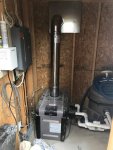Hi Everyone,
I have a new Hayward 250,000 BTU pool heater heating out small 12 x 24 inground pool.
Our heater is installed inside our pool house. When the installer connected the gas line he didn't have the duct work available to exhaust the heater out of the shed. However, he told me as long as I kept the pool house doors open, I could run the heater no problem. We did just that and the heater ran perfectly.
A few weeks later he arrived with the stainless steel duct work to run the exhaust outside our shed. He did this out the backside of the shed, rather than the ceiling (which I thought was odd, as I've never seen that before?). From the moment he installed the duct work, the heater makes borderline violent vibrations and noise. It almost sounds like a knocking/harley division motorcycle noise. It will do it on and off (5 mins of the vibrations and 2 mins of normal operation noise)... when I crank up our VS pump, the knocking, vibrations, etc. get even worse.
He came back to try and figure it out, without any luck. No he's MIA and I'm stuck trying to figure out what's happening?
It does it from low RPM to Max RPM on our Hayward VS Pump. Warm pool water and cold... doesn't matter. The only common theme is that it all started the day he installed the exhaust duct work venting.
Any ideas what's going on? Here is a photo of the exhaust venting he installed. Ignore the mess, it's been used as a storage shed during our backyard Renos.

I have a new Hayward 250,000 BTU pool heater heating out small 12 x 24 inground pool.
Our heater is installed inside our pool house. When the installer connected the gas line he didn't have the duct work available to exhaust the heater out of the shed. However, he told me as long as I kept the pool house doors open, I could run the heater no problem. We did just that and the heater ran perfectly.
A few weeks later he arrived with the stainless steel duct work to run the exhaust outside our shed. He did this out the backside of the shed, rather than the ceiling (which I thought was odd, as I've never seen that before?). From the moment he installed the duct work, the heater makes borderline violent vibrations and noise. It almost sounds like a knocking/harley division motorcycle noise. It will do it on and off (5 mins of the vibrations and 2 mins of normal operation noise)... when I crank up our VS pump, the knocking, vibrations, etc. get even worse.
He came back to try and figure it out, without any luck. No he's MIA and I'm stuck trying to figure out what's happening?
It does it from low RPM to Max RPM on our Hayward VS Pump. Warm pool water and cold... doesn't matter. The only common theme is that it all started the day he installed the exhaust duct work venting.
Any ideas what's going on? Here is a photo of the exhaust venting he installed. Ignore the mess, it's been used as a storage shed during our backyard Renos.


